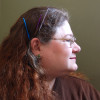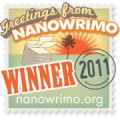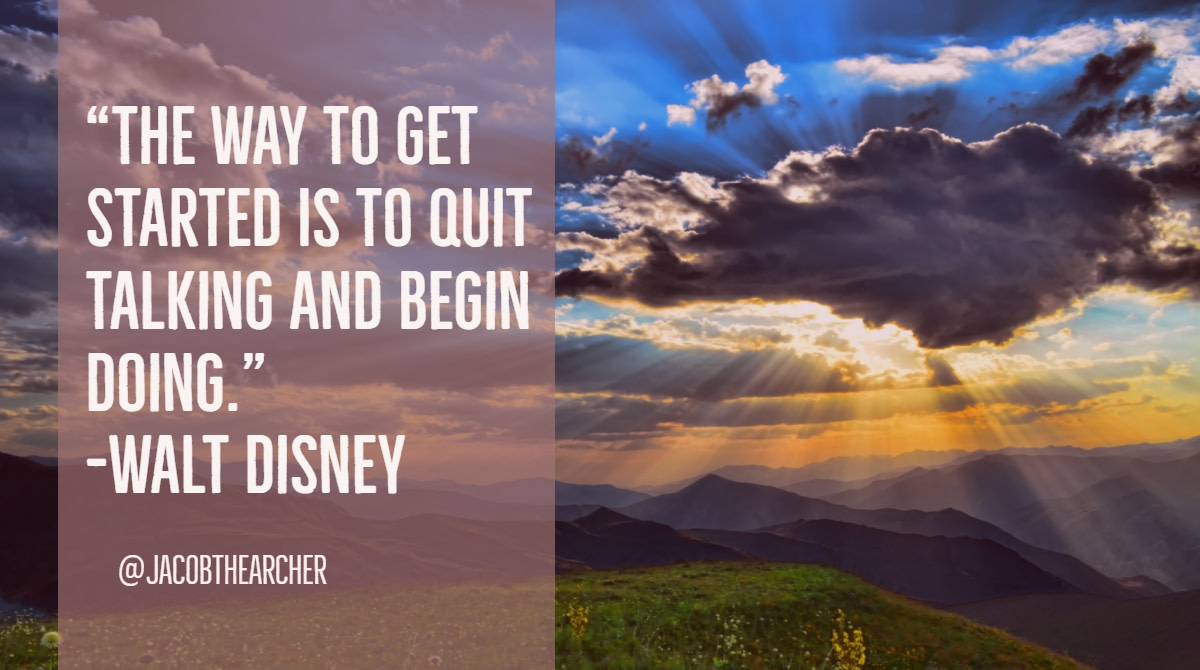Join National Novel Writing Month!
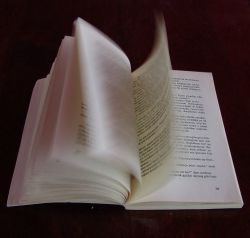
National Novel Writing Month - The Challenge and the Goal!
I've heard it said that everyone has a book inside them, just waiting to be written!
Have you ever dreamed of writing a book? Do you have a story inside you, just waiting to turned from dream to reality? Have you ever imagined being able to say, "I have written a book. I am a writer!"
Hopefully, inside your head is not the only place your story exists! If you have one, but just haven't gotten it out yet, perhaps joining NaNoWriMo - otherwise known as National Novel Writing Month - is the boost you need!
The Challenge: Write a novel.
The Goal: At least 50,000 words in one month.
Are you ready?
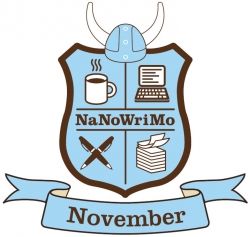
What is NaNoWriMo?
With a name like National Novel Writing Month, it's a bit obvious what NaNoWriMo is all about.
More specifically, NaNoWriMo is November. It's also a group and website. Participants in NaNoWriMo can register at the site for free. The site goes live in October, with official kick-off at 00:00 hours (12 am), November 1.
In the site, you can write a few details about your novel, keep track of your word count, join forums, gain writing buddies, and much more. The hard working people behind the site offer amazing support and assistance to members, with pep talk emails sent to your NaNoWriMo email address, resources available to all members and targeted information for regional groups.
There is also a Young Writers program for ages 17 and under, and even Camp NaNoWriMo! Many independent book stores and libraries take part with Write In nights.
Once writing commences, the funnest part is looking at your stats and updating your word count! You'll get information such as your average word count per day, total written on the current day, your goal for the day to achieve the goal of 50,000 words by the end of November, total words written, total words remaining, number of days remaining, and even the date you could reach 50,000 words at current pace, and the number of words you need to write per day to finish on time. There's even a handy graph that charts your daily word count, and another that shows the word count for your region.
Seeing those bars going up can be very motivating!
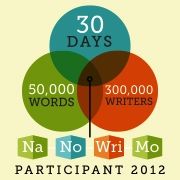
What do people write during NaNoWriMo?
Pretty much anything and everything!
Categories in the forums include action, historicial fiction, chick lit, horror and supernatural, romance, science fiction, religious, spiritual and new age, and even fan fiction, just to name a few! Some professional writers don't even write a novel. I recall reading about one person who, rather then starting a new novel of his own for the month, counted all his freelance writing that he needed to work on anyhow.
The important thing is that whatever you write is new for the month. You can't count stuff you started to write before November!
For myself, 2012 is my second year taking part in NaNoWriMo. I was able to meet the goal of 50,000 words in 2011. The novel I was working on, however, was incomplete, and I was unable to work on it again afterwards. So, I just continued with the same novel I'd started the year before.
Hopefully this year, I'll actually finish it!
Support NaNoWriMo!
While registering is always free, running NaNoWriMo does have expenses. These are paid for almost entirely by donations. If you decide to join NaNoWriMo, don't forget to donate at least a little to help pay for the wonderful support and resources these hard working people give.
You can also support them by buying some NaNoWriMo swag.
Succeeding at NaNoWriMo - Some hints and tips to help you reach 50,000 words in one month
The whole point of taking part in National Novel Writing Month is to get you writing! No more excuses! By setting a goal with a deadline, NaNoWriMo helps budding writers become novelists, and get the stories they have inside them OUT and written down.
Here are a few hints and tips that will help you reach your NaNoWriMo goal.
- Preparation: Sure, you've got your book in your head, but that might not be enough! Prepare ahead of time by writing an outline of your story. It can be very simple, with a start, middle and end, or elaborate, with outlines of every chapter, descriptions of every character, and eleborate plotlines and subplots all planned out. Generally, it's not a good idea to get too detailed, though, or you might find yourself spending so much time on the outline, the book never gets written! One piece of advice I heard from a professional writer about outlines was to begin with the end. Start your outline with how you want your novel to end, then work backwards. On the other hand, some people do better just winging it. Their story might end up completely different then they intended (and I've written more then a few short stories that turned out great using this method), but they got written, and that's the main thing that matters!
- Claim your space: Find a physical space that is just for you to write in, even if it's just a corner set up in a closet! Make sure your friends and family know that when you're in this space, you're working, and ask them to avoid interrupting you unless absolutely necessary. If there are too many interruptions or distractions at home, perhaps you can use the local library, a coffee shop or even an all night restaurant.
- Claim your time: This is perhaps the hardest thing to do! Set aside dedicated time to write, and ask the people around you to respect that time. When that time is will depend not only on your daily schedule and responsibilities, but also what your peak periods are. As an example, I'm a night owl. My best writing time is in the wee hours of the morning, when the rest of the family is in bed. Lately, I've found my most productive writing time has been from 3-5am! Some (strange, sad) people are morning people, who are more alert and productive if they get up earlier to get their writing time in. For others, it might be right after supper, or at lunch time. Whatever time you decide on, keep it up every day. Sure, some days, things just don't work out and you'll end up missing a day. Don't let that discourage you! Get back to it as quickly as you can and keep right on going!
- Register at the website: The NaNoWriMo website is just overflowing with useful information and resources. Plus, that's where you keep track of your word count! There are videos and pep talks to inspire you, forums to follow, and regional events to stay informed about. You could do NaNoWriMo on your own, but why make it harder for yourself?
- Take advantage of local events: Even before NaNoWriMo begins, there are often events you can take part in that will help you on your writing journey. Your local library might have a Writer in Residence available to help out, or they might have a kick-off night. Participating local independent bookstores will have areas set aside for NaNoWriters and offer support. Some businesses host overnight write-a-thons or some other write-in event, where you can join other NaNoWriters in your area, sit around with your laptops and beverages and ignore each other in mutual writing support. Check your region on the NaNoWriMo website to find out what's available.
- Build a support network: Hopefully, your friends and family will be understanding about this crazy project you're doing! Let them know what your goal is, and maybe even get some to participate with you! Ask people to be your Writing Buddy on the website, and you will be able to see each others statistics and progress bars, and you can send notes of encouragement to each other. Even if you are in a situation where you might not have any local support, there is a great deal of online support available.
- Write: Yes, I know, that should be obvious, but bear with me. NaNoWriMo is about writing. Not editing, not re-writing and not fussing or agonizing over your text. This isn't the time to worry about spelling or grammar, nor is it the time to worry about your writing even being good! Save all that for when the novel is finished. Keep the goal in mind. 50,000 words in a month.Once the novel is done, then you can go over it again mercilessly, hacking and slashing the garbage, beating the Typo Demon into submission, checking your spelling and grammar and ensuring your prose is actually worth reading. Save all of that for later and focus on the goal. Write.
Writing Your Novel
How should you do it?
When it comes to the physical act of writing your novel for National Novel Writing Month, you are free to use whatever method that inspires you the most! Here are some ideas.

Writing your novel by hand
Pen and ink, gel pen, ball point or pencil.
For some people, there is just no greater pleasure or inspiration then to put pen to paper!
Pen and Ink
On the plus side: Since writing by hand can be so much slower and it's harder to correct errors, it forces the writer to slow down and think carefully about the words he or she is about to write. A few Christmases back, my family bought me a wonderful calligraphy set consisting of a goosefeather quill with a brass holder at the tip for the selection of nibs it came with. There is just something romantic and meditative about dipping the pen into the ink, and carefully forming each letter. If you don't want a dip pen, there are also fountain and cartridge pens as well, and modern inks come in an amazing selection of colours and types. There are also gorgeous papers available to write on that make the experience a true joy.
On the minus side: Pen and ink, even when using cartridges, can be very messy. Extra time is also needed to allow the ink to dry. Plus, as with all manual writing methods, you will have to do the word count on your own, rather than having your software do it for you.
Ink or gel pens
On the plus side: Like pen and ink, writing with modern ink or gel pens is a wonderful tactile pleasure. Good quality pens are comfortable in the hands, with gloriously smooth running ink. The higher quality pens might cost a little more, but when doing a lot of writing, they are worth it. Also, gel pens in particular come in an inspiring range of colours.
On the minus side: While cleaner then dip, fountain or cartridge pens, writing with gel or ink pens can still be messier. Especially if you're left handed! Also, once a mistake is made, there's not much you can do about it. While there are erasable pens available now, the erased lines can come become visible again a few days later.
Pencil
On the plus side: Pencils have the benefit of being erasable. The leads are available in a variety of hardnesses, and mechanical pencils eliminate the need for sharpening entirely.
On the minus side: Even harder pencils can sometimes smudge. Being able to erase mistakes also means having little bits of eraser to brush away, so there's still the issue of a mess to clean up.
Whatever tools are used, unless you are already used to writing by hand, it can become quite painful to write for long periods of time. With a goal of 50,000 words in a month, speed also becomes and issue. While writing by hand is a pleasurable experience, I'd save it for short stories or poems, not a novel!

Writing your novel on a typewriter
Ah, memories! When I was in high school, I took typing class. It's probably the most useful class I ever took! Unlike the manual typewriter I had at home, where the keys needed to be hit so hard, I wore the tips of my fingernails flat, the ones in school were electric. What an amazing thing! Then there were the very first word processors, which were basically electric typewriters, except there was a tiny screen that displayed about 30 characters, and you could double check what you wrote before it actually typed the words for you.
How much technology has changed!
Typewriters are still around, though, and they still do the job.
On the plus side: There's something inspiring about the clackity clack of keys hitting paper, and the whirrrrrDING of hitting the return lever to start a new line. With a manual typewriter, there is no need to plug in anywhere and you can keep on typing, even if the power goes out. Of course, it's also a lot faster then by hand, plus it's easier to corrrect mistakes by whiting them out and typing over them.
On the minus side: Typewriters are getting harder to find, but harder still is getting the right ribbons needed for them. Also, if it breaks down, finding anyone who can repair it would be very difficult.
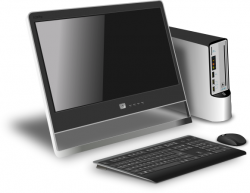
Writing your novel on a desktop
Most people these days have a computer of one kind or another - or several kinds! Modern computers have become ubiquitous, with good reason!
On the plus side: This being my personal preference, I have way too many plusses to list, so I'll just stick to a few. Being able to store your novel in electronic form is the biggest of them - you can have a backup on your own system, another in a cloud, another on a USB stick or a memory card, and so on. It's easy to write, edit, re-write, correct mistakes, re-write, edit some more and re-write.
Did I mention editing and rewriting? I think I did.
Of course, the biggest advantage for using a computer system during NaNoWriMo is that you can simply cut and paste your novel into the site, and it'll do the counting and updating for you. Using any of the previous methods above, you'd have to count all your words yourself, which not only takes time, but it's easy to lose track and make errors.
Finally, a desktop is the most comfortable of choices. There are some wonderful ergonomic keyboards available, and the larger monitors are much easier on the eyes!
On the minus side: Sometimes, what makes the job easy is also what makes it hard. Being able to so easily fix and change things, it can become tempting to do too many re-writes, and never get the job done!
For NaNoWriMo, this is something to avoid completely. The goal is to write a novel in a month, not publish a novel in a month! Save the editing and re-writes for after your novel is done. Until then, just write!
Another potential minus is losing your work. Quite a few writing tools and sites, such as Google Docs (now Google Drive) and resources specifically designed for NaNoWriMo, such as yarny.me will save automatically as you write. If you're using software such as MS Word, it's important to remember to save frequently. There's nothing more disheartening then to spend hours on your writing, only to have to suddenly disappear because of a technical glitch, and lose it all because it wasn't saved!
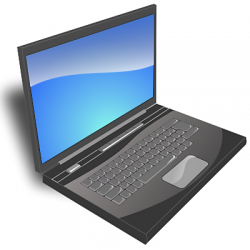
Writing your novel on a laptop
Laptops have become so much lighter and smaller, including those with larger screens, as well as affordable, many don't bother with desktop computers at all anymore!
On the plus side: Portability is the biggest plus for writing your novel on a laptop! While I prefer a desktop, there have been many times where I have borrowed my daughter's laptop so that I could work on my novel at the library or a coffee shop. With so many places that have free wi-fi available, I can access my novel on yarny.me from pretty much anywhere, and then pick up where I left off when I come back to my desktop.
Portability is also important for those times when you just have to get out of the house to write! I find that when I write at home, I frequently get distracted by all those things that need to be done, like the laundry, cooking meals, phone calls, etc. Even when the family is there and willing to take on those jobs, there are sometimes just too many distractions pulling me away from working on my novel. Using the laptop allows me to get away from all that, and get some work done!
On the minus side: My biggest beef with using a laptop is the keyboard. I like my ergonomic keyboard, and switching to a squished together laptop keyboard can become very painful, and there are a lot more typos because some of the keys are either in different places, or so close, they get hit accidentally. There's also the track pad. A few times, while backspacing to correct an error I made, I accidentally hit one of the buttons under the track pad - the "left click" button - and suddenly, my browser window has been backed up into my history by several pages. While yarny.me saves automatically, I still lost a few sentences when that happens!
Whenever possible, if I have the room to carry it, I bring along a spare ergonomic keyboard to plug into the laptop, as well as a wireless mouse so I don't have to use the track pad.
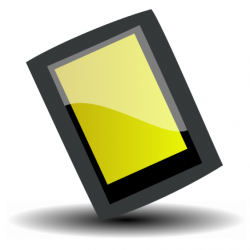
Writing your novel on a tablet or other handheld computer
Today's portable technology just amazes me! A simple hand held device such as a tablet, playbook or even smart phone can have many times more power and memory then any of the first computers I learned how to use back in high school! But then, the first computers I used in high school were Commadore 64's and used audio cassettes to store data.
Suddenly, I feel rather old!
On the plus side: There is just no beating hand held devices for portability and light weight.
On the minus side: Lack of a keyboard makes it extremely difficult to input the amounts of text involved in writing a novel. I've had some success setting my tablet up in a book holder, then using two fingers to type on the touchscreen, but I wouldn't want to do it for anything longer then a simple email! Some tablets have accessories that allow you to turn them into mini-notebook computers, which is an improvement, but their small size still makes typing difficult. Also, not all writing tools even have mobile compatible versions.
Using a hand held device might be okay in a pinch, but in the end, they're just not novel writing friendly!
Are you ready to write?
Well, there it is. Everything you need to know to take part in NaNoWriMo. Do you feel ready to write? Well, even if you don't, do it anyway!
After all, your book isn't going to write itself!
